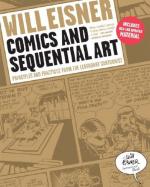
|
1. Give a brief synopsis of Chapter 1: Comics as a Form of Reading.
The chapter intends to introduce the philosophic connotations of sequential art from past to present. The chapter also places heavy focus on the relationship between reader/viewer and the storyteller, artist, or illustrator. This chapter also introduces how comics can make their own language and grammar.
2. Give a brief summary of the historical evolution of comics according to Chapter 1.
Eisner doesn't go into great detail, but he does explain that the growth and progression of comics came from daily strips circa 1934. Nowadays, the popular, modern comics are usually graphic novels read by younger adults.
3. Besides the text in comics, what must the reader/viewer "read"?
Comics are unique because they must be read for images, pictures, maps, musical notes, etc. The reader must learn to interpret visual images for verbal or emotive content.
(read all 60 Short Essay Questions and Answers)
|
This section contains 3,096 words (approx. 11 pages at 300 words per page) |

|




